Module 11 Unit 2 Here are some ways to welcome them. 课件 2023-2024学年外研版英语七年级下册(45张PPT)
文档属性
| 名称 | Module 11 Unit 2 Here are some ways to welcome them. 课件 2023-2024学年外研版英语七年级下册(45张PPT) | 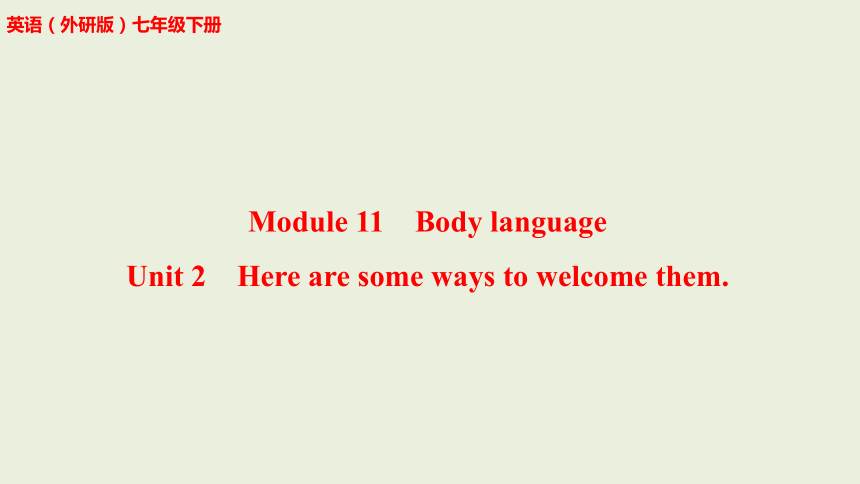 | |
| 格式 | pptx | ||
| 文件大小 | 280.0KB | ||
| 资源类型 | 教案 | ||
| 版本资源 | 外研版 | ||
| 科目 | 英语 | ||
| 更新时间 | 2024-02-23 12:16:17 | ||
图片预览

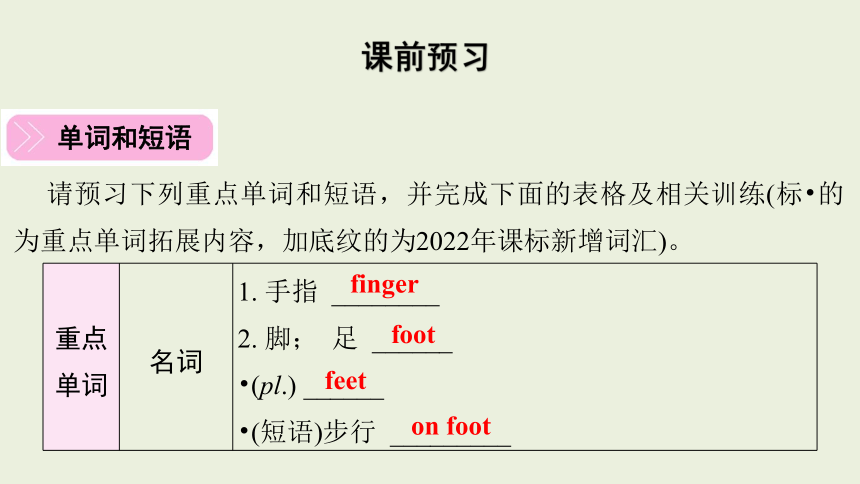

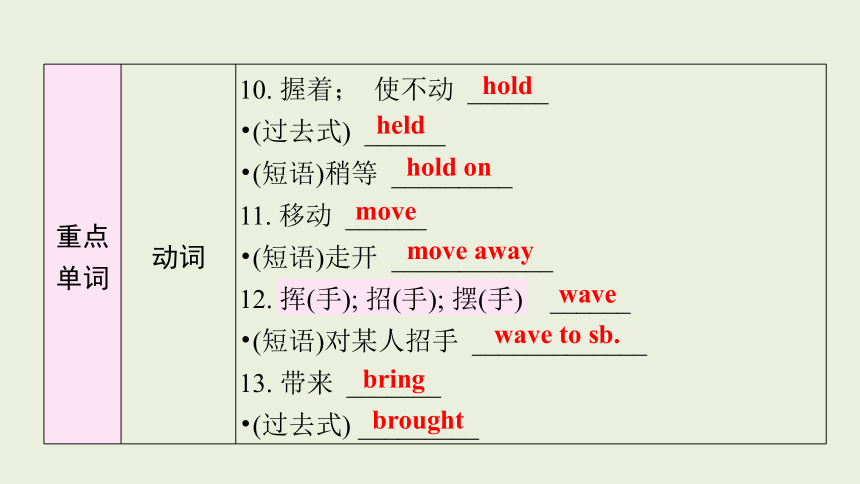





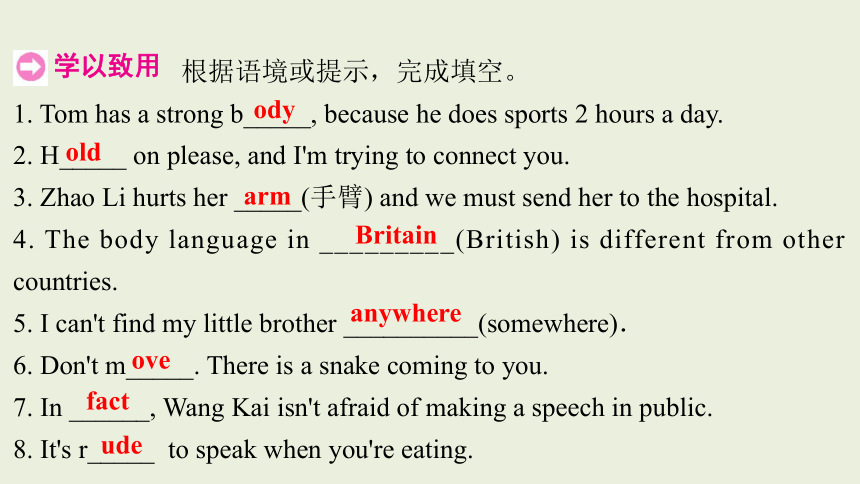
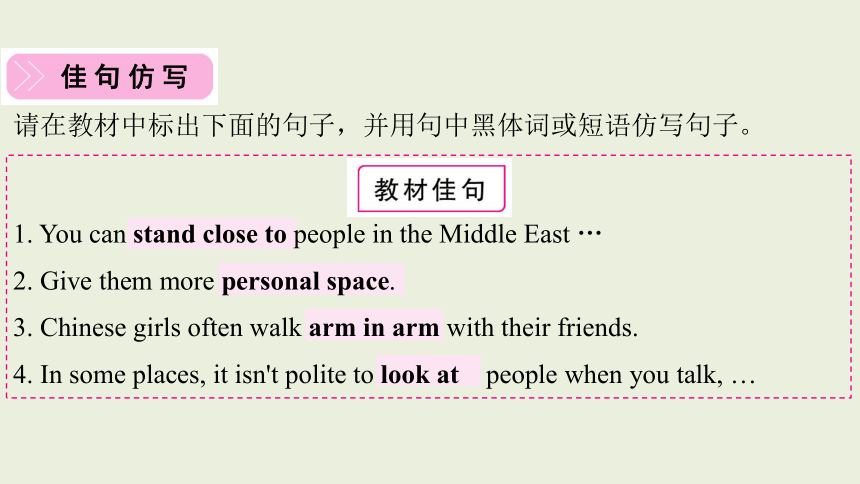

文档简介
(共45张PPT)
Module 11 Body language
Unit 2 Here are some ways to welcome them.
英语(外研版)七年级下册
单词和短语
请预习下列重点单词和短语,并完成下面的表格及相关训练(标 的为重点单词拓展内容,加底纹的为2022年课标新增词汇)。
重点 单词 名词 1. 手指 ________
2. 脚; 足 ______
(pl.) ______
(短语)步行 _________
finger
foot
feet
on foot
课前预习
重点 单词 名词 3. 膝盖 ________
4. 腿 _______
5. 嘴; 口 ________
6. 身体; 躯干 ______
(短语)肢体语言 _______________
7. 臂; 手臂 _____
(短语)臂挽臂地 ____________
8. 不列颠; 英国 _________
9. 事实; 细节 ______
(短语)事实上 _________
knee
leg
mouth
body
body language
arm
arm in arm
Britain
fact
in fact
重点 单词 动词 10. 握着; 使不动 ______
(过去式) ______
(短语)稍等 _________
11. 移动 ______
(短语)走开 ____________
12. 挥(手); 招(手); 摆(手) ______
(短语)对某人招手 _____________
13. 带来 _______
(过去式) _________
hold
held
hold on
move
move away
wave
wave to sb.
bring
brought
重点 单词 形容词 14. 外国的 _________
15. 个人的 ___________
16. 礼貌的 ________
17. 粗鲁的; 无礼的 ______
副词 18. 某处; 某个地方 ___________
foreign
personal
polite
rude
somewhere
重点 短语 1. 全世界 _____________________
2. 和某人谈话 __________________
3. 个人空间 ________________
4. 北美人 _________________
5. 南美人 _________________
6. 一点也不 ____________
7. 其他的地方 ________________
8. 挥手告别 _____________________
9. 当心,小心 ____________
10. 站得离……近 ________________
all over the world
talk to/with sb.
personal space
North American
South American
not at all
somewhere else
wave to say goodbye
be careful
stand close to
学习新单词,看音标学单词
/ f ɡ / finger 手指 n.
/f t/ foot 脚;足 n.
/ni / knee 膝盖 n.
/leɡ/ leg 腿 n.
/ma θ/ mouth 嘴;口 n.
/ b d / body 身体;躯干 n.
/ f r n/ foreign 外国的 adj.
/ p sn l/ personal 个人的 adj.
/ɑ m/ arm 臂;手臂 n.
/h ld/ hold 握着;使不动 v.
/mu v/ move 移动 v.
/'br tn/ Britain 不列颠;英国
/p la t/ polite 礼貌的 adj.
/ s m we / somewhere 某处;某个地方 adv.
/we v/ wave 挥(手);招(手); 摆(手) v.
/f kt/ fact 事实;细节 n.
/ru d/ rude 粗鲁的;无礼的 adj.
/br / bring 带来 v.
根据语境或提示,完成填空。
1. Tom has a strong b_____, because he does sports 2 hours a day.
2. H_____ on please, and I'm trying to connect you.
3. Zhao Li hurts her _____(手臂) and we must send her to the hospital.
4. The body language in _________(British) is different from other countries.
5. I can't find my little brother __________(somewhere).
6. Don't m_____. There is a snake coming to you.
7. In ______, Wang Kai isn't afraid of making a speech in public.
8. It's r_____ to speak when you're eating.
学以致用
ody
old
arm
Britain
anywhere
ove
fact
ude
佳 句 仿 写
1. You can stand close to people in the Middle East …
2. Give them more personal space.
3. Chinese girls often walk arm in arm with their friends.
4. In some places, it isn't polite to look at people when you talk, …
请在教材中标出下面的句子,并用句中黑体词或短语仿写句子。
不要跟老虎站得太近。
___________________________________
我们都需要私人空间。
__________________________________
挽着胳膊走路太危险了。
_________________________________________
看那朵云,真漂亮!
_______________________________________
Don't stand too close to tigers.
We all need our personal space.
It's too dangerous to walk arm in arm.
Look at the cloud. It's so beautiful!
课 文 理 解
快速阅读全文,回答下面的问题。
Q: How many kinds of body language are mentioned(提及) in the passage
A: _________________________________________________________
略读
一
Four (kinds of body language are mentioned in the passage).
课堂训练
通读全文,用完整句子回答下列问题。
1. Who is going to arrive soon
_____________________________________________________
2. What shouldn't we do when we talk to North Americans
______________________________________________________________________________
3. Who often walks arm in arm with friends according to the passage
__________________________________________________________
详读
二
Our new foreign students are going to arrive soon.
We shouldn't stand too close to North Americans/them (when we talk to them).
Chinese girls often walk arm in arm with their friends.
4. Which country's people don't like other people to touch them at all
________________________________________________________
5. How many places are mentioned in the passage
______________________________________________
British don't like other people to touch them at all.
Seven places are mentioned (in the passage).
请全面理解课文内容,并完成下列各小题。
A. 选择填空
( )1. In the Middle East, you can ________ when talking.
A. stand close to people B. stand far away from people
C. touch people D. hold people's arm
( )2. What's the passage mainly about
Some foreign students.
B. Some ways to welcome foreign students.
C. Different people use different language.
D. Different body language in different countries.
深读
三
A
D
B. 分享观点
读完短文,请围绕以下问题用几句话分享你的看法。
What other different body language do you know about
___________________________________________________________________________________________________________________________________________________________________________________
Eye contact is an important part of body language. But to be polite, don't look at the older people's eyes for a long time. To be polite to others, you can smile at others when talking with them.
A. 短文填空: 请根据课本内容,从方框内选择适当的词并用其正确形式填空,使文章完整连贯。注意每空一词,每词仅用一次,有两词为多余项。
读后回顾
四
stand polite but touch person arm and wave
People from foreign countries have different body language from us. People can stand close to others in the Middle East, 1. _____ don't do that in North America. So remember to leave some 2. __________ space when you talk with them. Chinese girls and South Americans sometimes hold your 3. _____. But in Britain, people don't like other people to 4. _______ them. In some countries, it isn't 5. ________ to look at people when you talk. And it isn't polite to 6. ______ to say goodbye in Greece. In fact, it's quite rude!
but
personal
arm
touch
polite
wave
B. 复述课文: 根据下面的线索复述文章大意。
知 识 探 究
1
Chinese girls often walk arm in arm with their friends. 中国女孩经常和朋友臂挽臂地一起走。
【自主探究】 arm in arm意为“ 臂挽臂地”。类似的表达还有:hand in hand“手牵手地”,shoulder by shoulder“肩并肩地”,face to face“面对面地”。
【习题演练】
1. 我的父母经常臂挽臂地一起散步。
My parents often go for a walk ____________.
arm in arm
2
... so you can't move away!……所以你不能走开!
【自主探究】 move away意为“离开; 移开; 搬走”。
move的用法
◆作不及物动词,意为“移动”。如:Don't move, because your arm is hurt. 别动,因为你的胳膊受伤了。
◆作及物动词,意为“移动; 搬迁; 感动”。如:
◇They moved house last year. 去年,他们搬家了。
◇What he said moved everyone. 他所说的话感动了每一个人。
【习题演练】
2. 我如此害怕以至于动不了。
I was so afraid that I can't ______.
move
3
In some places, it isn't polite to look at people when you talk, but in other countries it isn't polite to look somewhere else. 有些地方,交谈时看着对方是不礼貌的,但在其他国家,交谈时看别的地方是不礼貌的。
【自主探究1】 polite作形容词,意为“礼貌的”,be polite to sb. 意为”对某人有礼貌”;be polite to do sth.“做某事是礼貌的”。其反义词为impolite,意为“不礼貌的”或rude“粗鲁的”。其副词形式是politely,意为“礼貌地”。
【自主探究2】 somewhere作不定副词,意为“某处; 某个地方”,常用于肯定句中。somewhere else意为“别的某个地方”,当修饰语修饰不定代词或不定副词时,修饰语要后置。如:
I want something cool, because I'm very hot. 我想要点凉爽的东西,因为我很热。
anywhere是不定副词,意为“某个地方; 任何地方”,常用于疑问句、否定句中。如:
I can't find my bag anywhere. 我哪儿都找不到我的包。
【习题演练】
( )3. Do you see my mobile phone, Mike I can't find it ________.
A. somewhere B. nowhere
C. everywhere D. anywhere
4. With a smile, she shook hands with the guests __________(polite).
D
politely
【自主探究1】 wave在此处作不及物动词,意为“挥(手); 招(手); 摆(手)”,常见搭配:wave to sb.“向某人挥手”。如: Mary waves to me at the school gate. 玛丽在学校门口向我招手。
4
That's easy, wave to say goodbye. 那很简单,挥手告别。
wave还可作及物动词,意为“挥舞; 挥动”。如:
He waves a cap to say goodbye to me. 他挥舞着帽子向我道别。
【自主探究2】 say goodbye意为“告别”; say goodbye to sb. 意为“向某人说再见”。 类似的用法:say hello to sb. “向某人问好”; say sorry to sb. “向某人道歉”。
【习题演练】
5. 当妈妈看到我时,她就向我挥手。
When my mother saw me, she _____________.
6. 请替我跟汤姆道别。
Please ________________ Tom for me.
waved to me
say goodbye to
【自主探究】 ◆ not at all意为“一点儿也不; 完全不”,用来表示强烈否定。如:
—Are you tired?你累了吗?
—Not at all. 一点儿也不累。
◆not at all意为“不用谢; 没关系”,可用来回答别人礼貌的答谢。
5
In Greece, it's not at all polite!在希腊,这一点儿都不礼貌!
not … at all意为“一点儿也不……”,not常置于be动词、情态动词或助动词之后,at all 常放在句末。如: The girl can't speak English at all. 那个女孩一点儿英语也不会说。
【习题演练】
7. 这一点儿都不好玩!
It's ____________ funny!
not at all
一、 完成句子
1. 那对双胞胎正臂挽臂地购物。
The twins are doing some shopping ____________.
2. 小心,红灯亮了。
____________! The red light is on.
3. 事实上,我一点都不喜欢狗。
_________, I don't like dogs at all.
arm in arm
Be careful
In fact
课堂检测
4. 对我来说,跳舞是很快乐的。
It ____________________ dance.
5. 我的父母每天都和我谈话。
My parents _________ me every day.
is happy for me to
talk to
二、 短文填空(核心素养:语言能力)
请从方框内选择适当的词并用其正确形式填空,使文章完整连贯。注意每空一词,每词仅用一次,有两词为多余项。
When you speak, write a letter or make a telephone call, your words carry a message(信息). How do you know people also communicate without
1. _______ The smile on your face shows you are 2. __________ or happy.
in know also word and friend or book you tell but time
words
friendly
When you put up your hand in class, the teacher will know you want to say something 3. ____ ask questions. You shake your head 4. _____ people know you are saying “no”. Other things can 5. ______ carry messages. For example, a sign at the bus stop helps you 6. ______ which bus to take. A sign on the wall of 7. ______ school helps you find the library. There are so many signs around you and you receive messages from them all the 8. ______. People can also work 9. ____ many other ways. A writer can use his books to 10. ______ the wonderful things in the world and what other people are thinking about.
or
and
also
know
your
time
in
tell
一、 单句选词填空
rude personal foreign hold foot mouth wave finger
1. The shoes are too small for my ______.
2. Be polite!It's ______ to laugh at people.
3. Hold out(伸出) your hand, and count the numbers with your _________.
4. English isn't our first language, and it is a _________ language for us.
feet
rude
fingers
foreign
提能训练
5. Please open your _______ and say “Thank you” loudly to your teacher.
6. They ______ to us when they see us in the bus.
7. Don't tell others about your __________ information.
8. Tom is too little to ______ the cup.
mouth
wave
personal
hold
二、 完成句子
1. 这本书太枯燥,我一点儿也不喜欢它。
This book is too boring. I _______ like it ________.
2. 她和我们有不同的语言。
She has __________________________ us.
3. 请给我更多的私人空间。
Please give me _____________________.
4. 一群老人在臂挽臂地跳舞。
A group of old men are dancing ____________.
don't
at all
different languages from
more personal space
arm in arm
三、 阅读理解
B
Is body language important and useful The answer is “yes”. Because it can help people understand us easily. When we are communicating with others, we use not only words but also body language. For example, we use facial expressions(表情) to show our feelings. We use smiles to show we are happy. We also use gestures such as shaking hands with each other to show we are friendly.
However, different countries have different body language. For example, people in China and Australia shake hands when they meet others while Frenchmen and Russians greet others with kisses on the cheek. People from English-speaking countries do not like touching each other, but people in Puerto Rio like doing it. Therefore, if you touch someone from the UK, you should say sorry to him or her. If an American agrees with you, he will put his thumb(拇指) and forefinger(食指) into a circle(圆圈). But in Brazil, people think it is rude. In many countries, “thumbs up” means agreement. But people in Australia thought it was impolite to raise one's thumbs up.
Therefore, when we use body language in a foreign country, we should make sure if it is polite to do so there.
( )1. What does the underlined word “gestures” in Paragraph 1 mean
A. Body language. B. Hands.
C. Words. D. Smiles.
A
( )2. People in which country kiss cheeks when they meet others according to the passage
A. America. B. Russia.
C. China. D. Arab.
( )3. What does the underlined word “it” in Paragraph 2 refer to
B
A
( )4. Which of the following is TRUE
A. The British don't like touching each other.
B. “Thumbs up” in Australia means polite.
C. Chinese kiss each other when they meet.
D. Every country has the same body language.
A
( )5. What's the passage mainly about
A. How to communicate(交流) with others.
B. Why Western people use body language.
C. Different body language means differently in different countries.
D. Use different languages in different countries.
C
C
配对阅读。左栏是五名留学生的具体情况, 右栏是七项活动的介绍。请为每位学生选择一项合适的活动。
( )6. Ben is an Australian boy living in Hangzhou. He is interested in Chinese food.He wants to learn to cook some Chinese dishes. ( )7. Lisa loves Chinese kung fu. She wants to learn Tai Chi from Chinese. ( )8. Susan becomes interested in traditional Chinese art and she wants to learn how to cut paper into animals. ( )9. Sunny likes reading Chinese storybooks. She is reading a book about Monkey King this month. ( )10. Alex is from India. He is studying Chinese history. He wants to visit some places of interest in Xi'an one day. A. There will be a talk in our school this weekend. It is about Journey to the West(《西游记》), one of the four great Chinese books.
B. There will be a cooking class on Saturday. You can eat lots of delicious dishes here. And you can learn to cook them too.
C. Tai Chi is a world-famous exercise. Many Chinese people play Tai Chi in the park for exercising. You can join them and enjoy yourself.
D. There will be a two-day trip next weekend. You can see many old buildings in Xi'an. It's a good chance to learn more about Chinese history.
E. There will be a show of traditional Chinese paper cutting in the Art Museum this weekend. You can also learn how to cut paper into different things there.
F. In this weekend's movie time, you'll hear a lot of movies about Chinese kung fu, for example, Tai Chi Boxer.
G. Traditional Chinese painting is very popular in China. In our class, Mr Chen will teach you how to draw animals step by step.
B
C
E
A
D
Module 11 Body language
Unit 2 Here are some ways to welcome them.
英语(外研版)七年级下册
单词和短语
请预习下列重点单词和短语,并完成下面的表格及相关训练(标 的为重点单词拓展内容,加底纹的为2022年课标新增词汇)。
重点 单词 名词 1. 手指 ________
2. 脚; 足 ______
(pl.) ______
(短语)步行 _________
finger
foot
feet
on foot
课前预习
重点 单词 名词 3. 膝盖 ________
4. 腿 _______
5. 嘴; 口 ________
6. 身体; 躯干 ______
(短语)肢体语言 _______________
7. 臂; 手臂 _____
(短语)臂挽臂地 ____________
8. 不列颠; 英国 _________
9. 事实; 细节 ______
(短语)事实上 _________
knee
leg
mouth
body
body language
arm
arm in arm
Britain
fact
in fact
重点 单词 动词 10. 握着; 使不动 ______
(过去式) ______
(短语)稍等 _________
11. 移动 ______
(短语)走开 ____________
12. 挥(手); 招(手); 摆(手) ______
(短语)对某人招手 _____________
13. 带来 _______
(过去式) _________
hold
held
hold on
move
move away
wave
wave to sb.
bring
brought
重点 单词 形容词 14. 外国的 _________
15. 个人的 ___________
16. 礼貌的 ________
17. 粗鲁的; 无礼的 ______
副词 18. 某处; 某个地方 ___________
foreign
personal
polite
rude
somewhere
重点 短语 1. 全世界 _____________________
2. 和某人谈话 __________________
3. 个人空间 ________________
4. 北美人 _________________
5. 南美人 _________________
6. 一点也不 ____________
7. 其他的地方 ________________
8. 挥手告别 _____________________
9. 当心,小心 ____________
10. 站得离……近 ________________
all over the world
talk to/with sb.
personal space
North American
South American
not at all
somewhere else
wave to say goodbye
be careful
stand close to
学习新单词,看音标学单词
/ f ɡ / finger 手指 n.
/f t/ foot 脚;足 n.
/ni / knee 膝盖 n.
/leɡ/ leg 腿 n.
/ma θ/ mouth 嘴;口 n.
/ b d / body 身体;躯干 n.
/ f r n/ foreign 外国的 adj.
/ p sn l/ personal 个人的 adj.
/ɑ m/ arm 臂;手臂 n.
/h ld/ hold 握着;使不动 v.
/mu v/ move 移动 v.
/'br tn/ Britain 不列颠;英国
/p la t/ polite 礼貌的 adj.
/ s m we / somewhere 某处;某个地方 adv.
/we v/ wave 挥(手);招(手); 摆(手) v.
/f kt/ fact 事实;细节 n.
/ru d/ rude 粗鲁的;无礼的 adj.
/br / bring 带来 v.
根据语境或提示,完成填空。
1. Tom has a strong b_____, because he does sports 2 hours a day.
2. H_____ on please, and I'm trying to connect you.
3. Zhao Li hurts her _____(手臂) and we must send her to the hospital.
4. The body language in _________(British) is different from other countries.
5. I can't find my little brother __________(somewhere).
6. Don't m_____. There is a snake coming to you.
7. In ______, Wang Kai isn't afraid of making a speech in public.
8. It's r_____ to speak when you're eating.
学以致用
ody
old
arm
Britain
anywhere
ove
fact
ude
佳 句 仿 写
1. You can stand close to people in the Middle East …
2. Give them more personal space.
3. Chinese girls often walk arm in arm with their friends.
4. In some places, it isn't polite to look at people when you talk, …
请在教材中标出下面的句子,并用句中黑体词或短语仿写句子。
不要跟老虎站得太近。
___________________________________
我们都需要私人空间。
__________________________________
挽着胳膊走路太危险了。
_________________________________________
看那朵云,真漂亮!
_______________________________________
Don't stand too close to tigers.
We all need our personal space.
It's too dangerous to walk arm in arm.
Look at the cloud. It's so beautiful!
课 文 理 解
快速阅读全文,回答下面的问题。
Q: How many kinds of body language are mentioned(提及) in the passage
A: _________________________________________________________
略读
一
Four (kinds of body language are mentioned in the passage).
课堂训练
通读全文,用完整句子回答下列问题。
1. Who is going to arrive soon
_____________________________________________________
2. What shouldn't we do when we talk to North Americans
______________________________________________________________________________
3. Who often walks arm in arm with friends according to the passage
__________________________________________________________
详读
二
Our new foreign students are going to arrive soon.
We shouldn't stand too close to North Americans/them (when we talk to them).
Chinese girls often walk arm in arm with their friends.
4. Which country's people don't like other people to touch them at all
________________________________________________________
5. How many places are mentioned in the passage
______________________________________________
British don't like other people to touch them at all.
Seven places are mentioned (in the passage).
请全面理解课文内容,并完成下列各小题。
A. 选择填空
( )1. In the Middle East, you can ________ when talking.
A. stand close to people B. stand far away from people
C. touch people D. hold people's arm
( )2. What's the passage mainly about
Some foreign students.
B. Some ways to welcome foreign students.
C. Different people use different language.
D. Different body language in different countries.
深读
三
A
D
B. 分享观点
读完短文,请围绕以下问题用几句话分享你的看法。
What other different body language do you know about
___________________________________________________________________________________________________________________________________________________________________________________
Eye contact is an important part of body language. But to be polite, don't look at the older people's eyes for a long time. To be polite to others, you can smile at others when talking with them.
A. 短文填空: 请根据课本内容,从方框内选择适当的词并用其正确形式填空,使文章完整连贯。注意每空一词,每词仅用一次,有两词为多余项。
读后回顾
四
stand polite but touch person arm and wave
People from foreign countries have different body language from us. People can stand close to others in the Middle East, 1. _____ don't do that in North America. So remember to leave some 2. __________ space when you talk with them. Chinese girls and South Americans sometimes hold your 3. _____. But in Britain, people don't like other people to 4. _______ them. In some countries, it isn't 5. ________ to look at people when you talk. And it isn't polite to 6. ______ to say goodbye in Greece. In fact, it's quite rude!
but
personal
arm
touch
polite
wave
B. 复述课文: 根据下面的线索复述文章大意。
知 识 探 究
1
Chinese girls often walk arm in arm with their friends. 中国女孩经常和朋友臂挽臂地一起走。
【自主探究】 arm in arm意为“ 臂挽臂地”。类似的表达还有:hand in hand“手牵手地”,shoulder by shoulder“肩并肩地”,face to face“面对面地”。
【习题演练】
1. 我的父母经常臂挽臂地一起散步。
My parents often go for a walk ____________.
arm in arm
2
... so you can't move away!……所以你不能走开!
【自主探究】 move away意为“离开; 移开; 搬走”。
move的用法
◆作不及物动词,意为“移动”。如:Don't move, because your arm is hurt. 别动,因为你的胳膊受伤了。
◆作及物动词,意为“移动; 搬迁; 感动”。如:
◇They moved house last year. 去年,他们搬家了。
◇What he said moved everyone. 他所说的话感动了每一个人。
【习题演练】
2. 我如此害怕以至于动不了。
I was so afraid that I can't ______.
move
3
In some places, it isn't polite to look at people when you talk, but in other countries it isn't polite to look somewhere else. 有些地方,交谈时看着对方是不礼貌的,但在其他国家,交谈时看别的地方是不礼貌的。
【自主探究1】 polite作形容词,意为“礼貌的”,be polite to sb. 意为”对某人有礼貌”;be polite to do sth.“做某事是礼貌的”。其反义词为impolite,意为“不礼貌的”或rude“粗鲁的”。其副词形式是politely,意为“礼貌地”。
【自主探究2】 somewhere作不定副词,意为“某处; 某个地方”,常用于肯定句中。somewhere else意为“别的某个地方”,当修饰语修饰不定代词或不定副词时,修饰语要后置。如:
I want something cool, because I'm very hot. 我想要点凉爽的东西,因为我很热。
anywhere是不定副词,意为“某个地方; 任何地方”,常用于疑问句、否定句中。如:
I can't find my bag anywhere. 我哪儿都找不到我的包。
【习题演练】
( )3. Do you see my mobile phone, Mike I can't find it ________.
A. somewhere B. nowhere
C. everywhere D. anywhere
4. With a smile, she shook hands with the guests __________(polite).
D
politely
【自主探究1】 wave在此处作不及物动词,意为“挥(手); 招(手); 摆(手)”,常见搭配:wave to sb.“向某人挥手”。如: Mary waves to me at the school gate. 玛丽在学校门口向我招手。
4
That's easy, wave to say goodbye. 那很简单,挥手告别。
wave还可作及物动词,意为“挥舞; 挥动”。如:
He waves a cap to say goodbye to me. 他挥舞着帽子向我道别。
【自主探究2】 say goodbye意为“告别”; say goodbye to sb. 意为“向某人说再见”。 类似的用法:say hello to sb. “向某人问好”; say sorry to sb. “向某人道歉”。
【习题演练】
5. 当妈妈看到我时,她就向我挥手。
When my mother saw me, she _____________.
6. 请替我跟汤姆道别。
Please ________________ Tom for me.
waved to me
say goodbye to
【自主探究】 ◆ not at all意为“一点儿也不; 完全不”,用来表示强烈否定。如:
—Are you tired?你累了吗?
—Not at all. 一点儿也不累。
◆not at all意为“不用谢; 没关系”,可用来回答别人礼貌的答谢。
5
In Greece, it's not at all polite!在希腊,这一点儿都不礼貌!
not … at all意为“一点儿也不……”,not常置于be动词、情态动词或助动词之后,at all 常放在句末。如: The girl can't speak English at all. 那个女孩一点儿英语也不会说。
【习题演练】
7. 这一点儿都不好玩!
It's ____________ funny!
not at all
一、 完成句子
1. 那对双胞胎正臂挽臂地购物。
The twins are doing some shopping ____________.
2. 小心,红灯亮了。
____________! The red light is on.
3. 事实上,我一点都不喜欢狗。
_________, I don't like dogs at all.
arm in arm
Be careful
In fact
课堂检测
4. 对我来说,跳舞是很快乐的。
It ____________________ dance.
5. 我的父母每天都和我谈话。
My parents _________ me every day.
is happy for me to
talk to
二、 短文填空(核心素养:语言能力)
请从方框内选择适当的词并用其正确形式填空,使文章完整连贯。注意每空一词,每词仅用一次,有两词为多余项。
When you speak, write a letter or make a telephone call, your words carry a message(信息). How do you know people also communicate without
1. _______ The smile on your face shows you are 2. __________ or happy.
in know also word and friend or book you tell but time
words
friendly
When you put up your hand in class, the teacher will know you want to say something 3. ____ ask questions. You shake your head 4. _____ people know you are saying “no”. Other things can 5. ______ carry messages. For example, a sign at the bus stop helps you 6. ______ which bus to take. A sign on the wall of 7. ______ school helps you find the library. There are so many signs around you and you receive messages from them all the 8. ______. People can also work 9. ____ many other ways. A writer can use his books to 10. ______ the wonderful things in the world and what other people are thinking about.
or
and
also
know
your
time
in
tell
一、 单句选词填空
rude personal foreign hold foot mouth wave finger
1. The shoes are too small for my ______.
2. Be polite!It's ______ to laugh at people.
3. Hold out(伸出) your hand, and count the numbers with your _________.
4. English isn't our first language, and it is a _________ language for us.
feet
rude
fingers
foreign
提能训练
5. Please open your _______ and say “Thank you” loudly to your teacher.
6. They ______ to us when they see us in the bus.
7. Don't tell others about your __________ information.
8. Tom is too little to ______ the cup.
mouth
wave
personal
hold
二、 完成句子
1. 这本书太枯燥,我一点儿也不喜欢它。
This book is too boring. I _______ like it ________.
2. 她和我们有不同的语言。
She has __________________________ us.
3. 请给我更多的私人空间。
Please give me _____________________.
4. 一群老人在臂挽臂地跳舞。
A group of old men are dancing ____________.
don't
at all
different languages from
more personal space
arm in arm
三、 阅读理解
B
Is body language important and useful The answer is “yes”. Because it can help people understand us easily. When we are communicating with others, we use not only words but also body language. For example, we use facial expressions(表情) to show our feelings. We use smiles to show we are happy. We also use gestures such as shaking hands with each other to show we are friendly.
However, different countries have different body language. For example, people in China and Australia shake hands when they meet others while Frenchmen and Russians greet others with kisses on the cheek. People from English-speaking countries do not like touching each other, but people in Puerto Rio like doing it. Therefore, if you touch someone from the UK, you should say sorry to him or her. If an American agrees with you, he will put his thumb(拇指) and forefinger(食指) into a circle(圆圈). But in Brazil, people think it is rude. In many countries, “thumbs up” means agreement. But people in Australia thought it was impolite to raise one's thumbs up.
Therefore, when we use body language in a foreign country, we should make sure if it is polite to do so there.
( )1. What does the underlined word “gestures” in Paragraph 1 mean
A. Body language. B. Hands.
C. Words. D. Smiles.
A
( )2. People in which country kiss cheeks when they meet others according to the passage
A. America. B. Russia.
C. China. D. Arab.
( )3. What does the underlined word “it” in Paragraph 2 refer to
B
A
( )4. Which of the following is TRUE
A. The British don't like touching each other.
B. “Thumbs up” in Australia means polite.
C. Chinese kiss each other when they meet.
D. Every country has the same body language.
A
( )5. What's the passage mainly about
A. How to communicate(交流) with others.
B. Why Western people use body language.
C. Different body language means differently in different countries.
D. Use different languages in different countries.
C
C
配对阅读。左栏是五名留学生的具体情况, 右栏是七项活动的介绍。请为每位学生选择一项合适的活动。
( )6. Ben is an Australian boy living in Hangzhou. He is interested in Chinese food.He wants to learn to cook some Chinese dishes. ( )7. Lisa loves Chinese kung fu. She wants to learn Tai Chi from Chinese. ( )8. Susan becomes interested in traditional Chinese art and she wants to learn how to cut paper into animals. ( )9. Sunny likes reading Chinese storybooks. She is reading a book about Monkey King this month. ( )10. Alex is from India. He is studying Chinese history. He wants to visit some places of interest in Xi'an one day. A. There will be a talk in our school this weekend. It is about Journey to the West(《西游记》), one of the four great Chinese books.
B. There will be a cooking class on Saturday. You can eat lots of delicious dishes here. And you can learn to cook them too.
C. Tai Chi is a world-famous exercise. Many Chinese people play Tai Chi in the park for exercising. You can join them and enjoy yourself.
D. There will be a two-day trip next weekend. You can see many old buildings in Xi'an. It's a good chance to learn more about Chinese history.
E. There will be a show of traditional Chinese paper cutting in the Art Museum this weekend. You can also learn how to cut paper into different things there.
F. In this weekend's movie time, you'll hear a lot of movies about Chinese kung fu, for example, Tai Chi Boxer.
G. Traditional Chinese painting is very popular in China. In our class, Mr Chen will teach you how to draw animals step by step.
B
C
E
A
D
同课章节目录
- Module 1 Lost and found
- Unit 1 Whose bag is this?
- Unit 2 Are they yours?
- Unit 3 Language in use
- Module 2 What can you do ?
- Unit 1 I can play the piano
- Unit 2 I can run really fast
- Unit 3 Language in use
- Module 3 Making plans
- Unit 1 What are you going to do at the weekends?
- Unit 2 We're going to cheer the players.
- Unit 3 Language in use
- Module 4 Life in the future
- Unit 1 Everyone will study at home
- Unit 2 Every family will have a small plane.
- Unit 3 Language in use
- Module 5 Shopping
- Unit 1 What can I do for you?
- Unit 2 You can buy everything on the Internet
- Unit 3 Language in use
- Module 6 Around town
- Unit 1 Could you tell me how to get to the Nationa
- Unit 2 The London Eye is on your right.
- Unit 3 Language in use
- Revision module A
- Module 7 My past life
- Unit 1 I was born in a small village.
- Unit 2 I was born in Quincy.
- Unit 3 Language in use
- Module 8 Story time
- Unit 1 Once upon a time….
- Unit 2 Goldilocks hurried out of the house.
- Unit 3 Language in use
- Module 9 Life history
- Unit 1 He left school and began work at the age of
- Unit 2 He decided to be an actor.
- Unit 3 Language in use
- Module 10 A holiday journey
- Unit 1 What did you do?
- Unit 2 This morning we took a walk.
- Unit 3 Language in use
- Module 11 Body language
- Unit 1 They touch noses!
- Unit 2 Here are some ways to welcome them.
- Unit 3 Language in use
- Module 12 Western music
- Unit 1 It's so beautiful!
- Unit 2 Vienna is the centre of European classical
- Unit 3 Language in use
- Revision module B
